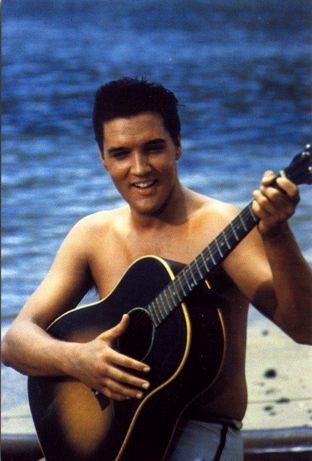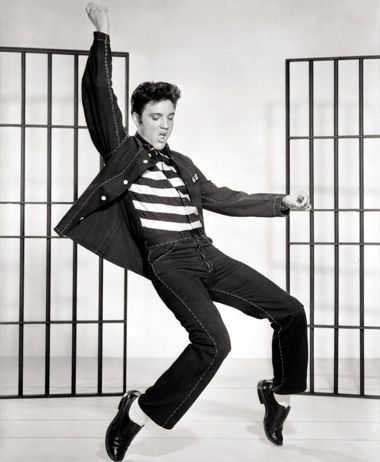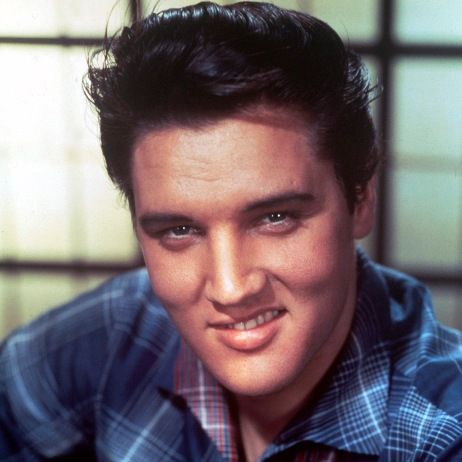
Want to know the best Elvis Presley movies? How about the worst Elvis Presley movies? Curious about Elvis Presley box office grosses or which Elvis Presley movie picked up the most Oscar® nominations? Need to know which Elvis Presley movie got the best reviews from critics and audiences…and which Elvis movie got the worst reviews? Well you have come to the right place …. because we have all of that information.
Elvis Presley (1935-1977) the singer was the “King of Rock and Roll”. The “King” has sold over 2.5 billion in worldwide records. Following in the footsteps of Bing Crosby and Frank Sinatra, Presley went from singing to acting in movies. Elvis Presley’s first number one song, Heartbreak Hotel, was released in January 1956. By the end of 1957 he had appeared in three movies (Love Me Tender, Loving You, and Jailhouse Rock) and they were all box office hits. After Presley finished filming King Creole he was drafted. He would return to movies with G.I. Blues in 1960. For the rest of the 1960s he averaged nearly three movies a year.
When looking at his IMDb page you find some pretty interesting Elvis Presley credits. Presley has 31 acting credits. His music has been featured in 397 movies and television shows. And he appeared as himself in 23 projects…including many documentaries. This page will rank 31 Elvis Presley movies from Best to Worst in six different sortable columns of information. Television shows, shorts, cameos and movies that were not released in theaters were not included in the rankings….I did include two of his most famous documentaries in the rankings.

Elvis Presley Movies Ranked In Chronological Order With Ultimate Movie Rankings Score (1 to 5 UMR Tickets) *Best combo of box office, reviews and awards.
Year
Movie (Year)
Rating
S
Year Movie (Year) Rating S
1957
Jailhouse Rock (1957)
![]()
1964
Viva Las Vegas (1964)
![]()
1957
Loving You (1957)
![]()
1960
G.I. Blues (1960)
![]()
1961
Blue Hawaii (1961)
![]()
1956
Love Me Tender (1956)
![]()
1962
Follow That Dream (1962)
![]()
1960
Flaming Star (1960)
![]()
1958
King Creole (1958)
![]()
1965
Girl Happy (1965)
![]()
1964
Roustabout (1964)
![]()
1962
Girls! Girls! Girls! (1962)
![]()
1962
Kid Galahad (1962)
![]()
1963
Fun in Acapulco (1963)
![]()
1965
Tickle Me (1965)
![]()
1970
Elvis: That's the Way It Is (1970)
![]()
1961
Wild in the Country (1961)
![]()
1968
Speedway (1968)
![]()
1964
Kissin' Cousins (1964)
![]()
1966
Paradise, Hawaiian Style (1966)
![]()
1966
Spinout (1966)
![]()
1981
This Is Elvis (1981)
![]()
1966
Frankie and Johnny (1966)
![]()
1972
Elvis On Tour (1972)
![]()
1969
Charro! (1969)
![]()
1968
Live a Little, Love a Little (1968)
![]()
1963
It Happened at the World's Fair (1963)
![]()
1967
Double Trouble (1967)
![]()
1967
Clambake (1967)
![]()
1969
The Trouble with Girls (1969)
![]()
1967
Easy Come, Easy Go (1967)
![]()
1968
Stay Away, Joe (1968)
![]()
1965
Harum Scarum (1965)
![]()
1969
Change of Habit (1969)
![]()
Elvis Presley Movies Can Be Ranked 6 Ways In This Table
The really cool thing about this table is that it is “user-sortable”. Rank the movies anyway you want.
- Sort by Elvis Presley movie titles…link takes you to that movie’s trailer
- Sort by Elvis Presley’s co-stars of his movies.
- Sort Elvis Presley movies by actual domestic box office grosses using current movie ticket cost
- Sort Elvis Presley movies by adjusted domestic box office grosses using current movie ticket cost
- Sort Elvis Presley movies by movie’s domestic yearly box office rank
- Sort Elvis Presley movies how they were received by critics and audiences. 60% rating or higher should indicate a good movie.
- Sort Elvis Presley movies by Ultimate Movie Rankings (UMR) Score. UMR Score puts box office, reviews and awards into a mathematical equation and gives each movie a score.
| R | Movie (Year) | UMR Co-Star Links | Adj. B.O. Worldwide (mil) | Review | Oscar Nom / Win | UMR Score | ||||
|---|---|---|---|---|---|---|---|---|---|---|
| R | Movie (Year) | UMR Co-Star Links | Actual B.O. Domestic (mil) | Adj. B.O. Domestic (mil) | Adj. B.O. Worldwide (mil) | B.O. Rank by Year | Review | Oscar Nom / Win | UMR Score | S |
| 1 | Jailhouse Rock (1957) | Judy Taylor | 11.10 | 233.8 | 233.80 | 13 | 71 | 00 / 00 | 95.1 | |
| 2 | Viva Las Vegas (1964) | Ann-Margret | 14.70 | 184.0 | 184.00 | 10 | 72 | 00 / 00 | 93.9 | |
| 3 | Loving You (1957) | Lizabeth Scott | 10.60 | 221.8 | 221.80 | 17 | 66 | 00 / 00 | 93.5 | |
| 4 | G.I. Blues (1960) | Juliet Prowse | 12.30 | 209.2 | 209.20 | 16 | 65 | 00 / 00 | 93.4 | |
| 5 | Blue Hawaii (1961) | Angela Lansbury | 13.40 | 213.2 | 213.20 | 11 | 64 | 00 / 00 | 93.0 | |
| 6 | Love Me Tender (1956) | Richard Egan | 12.00 | 256.4 | 256.40 | 20 | 60 | 00 / 00 | 91.7 | |
| 7 | Follow That Dream (1962) | Arthur O'Connell | 7.70 | 120.9 | 120.90 | 30 | 66 | 00 / 00 | 84.4 | |
| 8 | Flaming Star (1960) | Barbara Eden | 5.70 | 97.3 | 97.30 | 49 | 72 | 00 / 00 | 83.9 | |
| 9 | King Creole (1958) | Walter Matthau | 3.40 | 67.1 | 67.10 | 64 | 79 | 00 / 00 | 82.9 | |
| 10 | Girl Happy (1965) | Shelly Fabares | 8.60 | 98.9 | 98.90 | 33 | 65 | 00 / 00 | 80.4 | |
| 11 | Roustabout (1964) | Barbara Stanwyck | 9.00 | 112.5 | 112.50 | 29 | 60 | 00 / 00 | 80.0 | |
| 12 | Girls! Girls! Girls! (1962) | Stella Stevens | 9.40 | 147.7 | 147.70 | 27 | 46 | 00 / 00 | 78.2 | |
| 13 | Kid Galahad (1962) | Charles Bronson | 6.10 | 95.1 | 95.10 | 44 | 61 | 00 / 00 | 77.2 | |
| 14 | Fun in Acapulco (1963) | Ursula Andress | 8.00 | 109.3 | 109.30 | 35 | 56 | 00 / 00 | 76.7 | |
| 15 | Tickle Me (1965) | Julie Adams | 8.10 | 93.4 | 93.40 | 38 | 60 | 00 / 00 | 76.3 | |
| 16 | Elvis: That's the Way It Is (1970) | Elvis Documentary | 3.00 | 23.0 | 23.00 | 82 | 82 | 00 / 00 | 75.7 | |
| 17 | Wild in the Country (1961) | Tuesday Weld | 6.10 | 96.9 | 96.90 | 39 | 56 | 00 / 00 | 73.2 | |
| 18 | Speedway (1968) | Nancy Sinatra | 8.60 | 76.9 | 76.90 | 42 | 59 | 00 / 00 | 70.5 | |
| 19 | Kissin' Cousins (1964) | Arthur O'Connell | 8.30 | 103.6 | 103.60 | 33 | 49 | 00 / 00 | 68.7 | |
| 20 | Paradise, Hawaiian Style (1966) | Suzanne Leigh | 7.10 | 76.1 | 76.10 | 40 | 57 | 00 / 00 | 67.7 | |
| 21 | Spinout (1966) | Shelly Fabares | 6.00 | 63.7 | 63.70 | 47 | 58 | 00 / 00 | 64.1 | |
| 22 | This Is Elvis (1981) | Elvis Presley & David Scott |
2.00 | 8.6 | 8.60 | 115 | 75 | 00 / 00 | 62.9 | |
| 23 | Frankie and Johnny (1966) | Harry Morgan | 6.00 | 64.1 | 64.10 | 46 | 53 | 00 / 00 | 56.7 | |
| 24 | Elvis On Tour (1972) | Elvis Documentary | 2.70 | 18.9 | 18.90 | 100 | 64 | 00 / 00 | 49.9 | |
| 25 | Charro! (1969) | Victor French | 3.90 | 32.5 | 32.50 | 59 | 58 | 00 / 00 | 47.5 | |
| 26 | Live a Little, Love a Little (1968) | Dick Sargent | 2.70 | 24.3 | 24.30 | 102 | 60 | 00 / 00 | 45.2 | |
| 27 | It Happened at the World's Fair (1963) | Kurt Russell | 6.80 | 92.7 | 92.70 | 42 | 37 | 00 / 00 | 43.5 | |
| 28 | Double Trouble (1967) | Annette Day | 4.00 | 38.8 | 38.80 | 61 | 52 | 00 / 00 | 37.9 | |
| 29 | Clambake (1967) | Shelly Fabares | 2.20 | 21.8 | 21.80 | 90 | 57 | 00 / 00 | 36.8 | |
| 30 | The Trouble with Girls (1969) | Marlyn Mason | 2.70 | 22.7 | 22.70 | 79 | 56 | 00 / 00 | 36.6 | |
| 31 | Easy Come, Easy Go (1967) | Elsa Lanchester | 4.80 | 46.7 | 46.70 | 52 | 45 | 00 / 00 | 29.2 | |
| 32 | Stay Away, Joe (1968) | Burgess Meredith | 4.30 | 38.4 | 38.40 | 69 | 47 | 00 / 00 | 27.3 | |
| 33 | Harum Scarum (1965) | Mary Ann Mobley | 4.10 | 46.7 | 46.70 | 65 | 40 | 00 / 00 | 19.1 | |
| 34 | Change of Habit (1969) | Mary Tyler Moore | 1.60 | 13.3 | 13.30 | 115 | 31 | 00 / 00 | 2.0 |
Stats and Possibly Interesting Things From The Above Elvis Presley Table
- Seven Elvis Presley movies crossed the magical $100 million domestic gross mark. That is a percentage of 21.21% of his movies listed. Love Me Tender (1956) was his biggest box office hit.
- An average Elvis Presley movie grosses $68.70 million in adjusted box office gross.
- Using RottenTomatoes.com’s 60% fresh meter. 14 of Elvis Presley’s movies are rated as good movies…or 42.42% of his movies. King Creole (1958) is his highest rated movie* while Change of Habit (1969) was his lowest rated movie. *Documentaries excluded.
- Zero Elvis Presley movies received at least one Oscar® nomination in any category…..or 0.00% of his movies.
- A “good movie” Ultimate Movie Rankings (UMR) Score is 60. 12 Elvis Presley movies scored higher that average….or 36.36% of his movies. Jailhouse Rock (1957) got the the highest UMR Score while Change of Habit (1969) got the lowest UMR Score.

Check out Elvis Presley‘s career compared to current and classic actors. Most 100 Million Dollar Movies of All-Time.
If you are interested in Elvis’ Top 40 Billboard Hits…..we have 107 Elvis Songs Ranked Best To Worst as well. Elvis Top 40 Hits.
If you do a comment….please ignore the email address and website section.

About to watch my annual Thanksgiving movie. Love Elvis period. But really love him in Blue Hawaii.
Bob
“development of techniques and mediums especially TV, making things more competitive so that in the 2nd half of the century the competition ante has been upped.”
Honestly, I don’t know if what can tell if it was harder to be a major media star in the 1930”s let’s say, than today.
But that isn’t exactly my point.
To use a sports analogy, is it harder to be a baseball superstar today than it was in Joe DiMaggio’s day. One could argue the competition argument both ways, I suppose. But one thing I think is almost beyond real dispute. Joe DiMaggio was much better known as a baseball superstar in his prime than any active player is. Baseball has declined, and other sports have gained a stronger foothold.
But if you are talking about the 1930’s and 1940’s, you can’t equate any basketball or football player with DiMaggio. DiMaggio was far more famous. A far greater cultural icon.
I think this is also true of movie stars back then. They were the major cultural icons, and certainly the major cultural icons who have endured.
The competition issue is somewhat different. Perhaps it was easier for Crosby to be both the top movie ticket seller and record seller for years, and a top radio star, than it would be for any one to have similar success today.
But that doesn’t alter the fact that he did it.
And I think that fact can’t be ignored if you are going to evaluate 20th century cultural icons.
The second paragraph should read
“I don’t know if one could tell if it was harder to be a major media star in the 1930’s, let’s say, than today.”
Another typo. Getting old.
Hey John…it is happening (getting older) to every man, woman and child living…..lol.
Bob
Gary Cooper in The Plainsmen.
I didn’t think much of this criticism. Cooper was under contract to Paramount. I think he had to make this movie and do that scene. (It has been a long time since I saw this film, and I don’t recall much of it nor that scene) He was assigned to it and during the studio era you did what you were told to do. And DeMille was a big cheese in Hollywood. Your criticism of the scene might be more accurately directed at DeMille than at Cooper.
1 That scene WAS in the film unless they were ultimately so embarrassed by it that they later removed it in the way that they did for a time the Duke’s entire movie Jet Pilot.
2 My point was that in my opinion it was easier to act in this kind of dumb down stuff than to give the type of in depth portrayal that Monty Clift gave in A Place in the Sun which Orson Welles described as “The greatest film ever made about America.” Cooper would have been incapable of that quality or depth of performance in his younger days but he gave some excellent performances as he got older as I have always contended and indeed I found the older Coop a joy to watch.
2 If the Plainsman rubbish was the kind of movies that others were putting him into that was not his fault as you say but we can only judge by what he did. He did of course make some good movies too in those early days but I found something terribly lacking in his performances even in the best ones back then. Certainly that scene from Plainsman would have been more suited to The Marx Bros Go West and it was also dishonest as it pedalled myths about Indians.
BOB
Bob
I don’t dispute the scene was in the film. My only point was that I personally don’t remember much about the film and don’t remember that scene at all so it is hard to comment directly on it. I probably saw the film back in the 1970’s or so.
It is a solid point that this film was part of his career and he in fact did it.
On the other hand, Cooper made more films by far than Clift and Brando combined, although if one added up the years they made films, it would come to about 70 to his 35. Cooper was the type of blue collar working actor the industry was built on in those days. Working that often there are bound to be dogs, but what of the better films. None of his pre-WWII films are worthwhile?
Bob
“He did of course make some good movies too in those early days”
This one went past me w/o sinking in, so my “None of his pre-WWII films are worthwhile?”
is out of place. I retract it, but can’t edit it out
HI JOHN
1 Other films that he made as I’ve already conceded were worthwhile but I personally think others in them would have made them even better as he had a very limited range of acting skills though he enlarged those as he got older. The fact that Brando and Clift got such great reputations with quarter to half the films of the likes of Cooper actually increases my admiration for the former two. If I may paraphrase a leading critic historian who said that “if Brando had decided to live on the set churning out standard westerns he wouldn’t have been Brando he would have been Cooper.” As it is I think that The Godfather is Bruce’s highest UMR scored movie and is also 1st on IMD’s list of greatest movies updated 3 months ago.
2 However you have given me quite a lot to think about and I want to be comprehensive in my response so it will be tomorrow before I can give you a full reply
In the meantime let me express my gratitude to you for engaging in these exchanges from which I have already learnt some new things and I think I will learn more.
Best wishes BOB.
Hey Bob and John
1. I think it is safe to say the are both legends.
2. As for The Plainsman….I have not seen that…so I have to defer to stats…..so The Plainsman got Cooper a 4.0 star rating (which is the highest possible) from Joel Hirchhorn’s Rating The Movie Stars book. One of 19 Cooper movies that Hirschhorn gave a 4.0 star rating to.
3. When looking at my Cooper page…The Plainsman…is ranked as Coop’s 53rd best movie or 18th worst movie…and with a critic/audience rating under 60%….which is the threshold of a good movie or not….(at least in Rotten Tomatoes.com’s opinion).
4. So I think the stats show why you two have different opinons on the movie…..lots of people thought the movie was ok…while others thought it was pretty good….Cooper’s star power made it a Top 40 movie of the year at the box office.
5. Either way….all of your points were entertaining to read….thanks for sharing those movie thoughts…it is greatly appreciated.
Bob
“Gary Cooper”
But my point isn’t that Cooper was better than Brando. I don’t think he was. And among the stars of the thirties and forties, I would consider Stewart, Tracy, Fonda, and Cagney, at least, to be better actors on balance. My point that Cooper arrived at the hinge of technological change. He was one of the last silent stars and easily transitioned to talkies. He never had stage training, so his technique from the outset was to act to the camera and the overhanging microphone. He didn’t have to unlearn projecting to the rear seats.
Cooper is important not because he was the best, but because he was the first, or perhaps more precisely, the earliest to have a big impact. Crosby is the equivalent in singing. While one might argue Gene Austin or Rudy Vallee were the first crooners, it was Crosby who became the one identified with singing to the microphone rather than the rear seats. Was he the best? I think Sinatra and Cole and some other of the later crooners were better, but Crosby was the man who set the mode, as did Cooper.
But just to be fair. Plenty of folks saw Cooper as a little bit more, despite limitations, than just wooden.
John Barrymore–“That fellow is the world’s greatest actor.”
Lee Strasberg–“The simplest examples of Stanislavski’s ideas are actors like Gary Cooper.”
Ingrid Bergman–“The most natural actor I ever worked with.”
Cooper won two Oscars, a Golden Globe, and a New York Film Critics, best actor award.
He was a respected actor by the critics and his peers.
Bob & Cogerson
Lots of issues to discuss. Because of so many, I think it best to deal with one at a time.
First–Sports stars as entertainers.
I don’t think viewing sports as part of the entertainment world is particularly new. In both straight entertainment and sports folks are paying to see someone perform. And there has always been crossovers. Ice follies or aquacades were venues for actor/athlete’s like Sonja Henie or Johnny Weissmuller or Esther Williams. The circus is another venue where being a performer and being an athlete sort of merge.
I read an interesting article in a boxing blog not long ago. The article was very much in depth and showed excellent research. It was about the film of the Corbett-Fitzsimmons fight in 1897. The fight went 14 rounds, so the film, with subtitled intros, etc., and conclusion, ran over an hour. The author explained that it was the first feature film to gross more than $1 million dollars in the USA. It was explained how exhibitors took it around the country. There weren’t movie theatres yet, but regular theatres, and even town halls or churches, and even barns, were used for viewing. Interestingly, the film was widescreen. I didn’t realize they had any way of doing that back then. So it seems that sports and entertainment were joined at the hip right from the beginning.
Corbett, by the way, was a successful stage actor both during and after his championship reign, and almost all heavyweight champions dabbled with the stage or movies. So did other sports icons. I have seen films starring Babe Ruth and Red Grange. (the serial The Galloping Ghost starring Grange is not all that bad)
And boxers, at least, were famous in much of the world. In the 1920’s, Jack Dempsey had only two fights between July 4, 1921 and September 1926, in July and Sept of 1923. Why? He could make more money from personal appearances and exhibitions and occasional stage and movie performances. (Dempsey did a serial–now lost–in 1920 as the hero. The villain was Lon Chaney. The director Woody Van Dyke. Dempsey’s exhibitions were not only in the USA but in other parts of the world. Max Schmeling commented in his autobiography on the thrill he got as a teenager when he got the chance to spar with his boyhood idol, Dempsey.
To stop my rambling, I think athlete’s have always been mixed up in entertainment if there was a buck to be made. Were they viewed as entertainers? Well, on the old American TV show What’s My Line, when a mystery guest was an athlete and a panelist began the questioning by asking if he were part of the entertainment world, John Daly’s answer was yes.
So I would dispute that anything has really changed here.
Hey John….good points about sports figures. In the states….Peyton Manning (an American football player) is one of the most popular figures in the country and he does not even play anymore.
Now that is very interesting about the Corbett-Fitzsimmons fight being the first $1 million dollar movie…thanks for sharing that. It actually gets me to remember about the Cyclorama in Atlanta Georgia. That is pretty much the first movie…..they were huge paintings that were slowly unrolled in front of audiences….and telling the story as the more of the painting was revealed….they started doing cycloramas in the late 1790s. https://en.wikipedia.org/wiki/Cyclorama
As for boxers…the Heavyweight Champion of the World…used to mean something….now it means almost nothing. I love sports….I used to watch boxing…at one point I could name all the heavyweight champs by the many ABC titles they had…..now I know zero of the champions….and the only fighters that get mentioned are UFC (I think that is the name) ones. Time changes everything….but Dempsey, Ruth and Grange will always live on.
Thanks for a great comment.